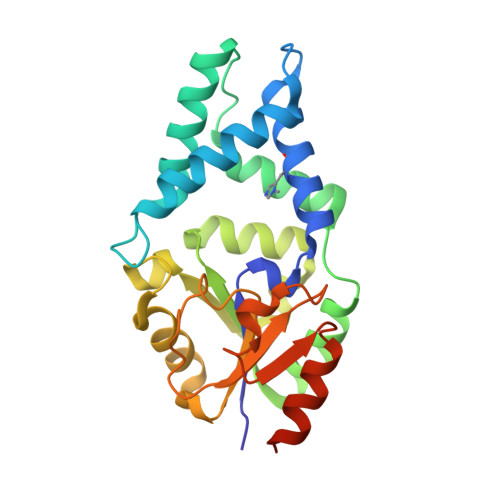A non-canonical nucleophile unlocks a new mechanistic pathway in a designed enzyme.
Hutton, A.E., Foster, J., Crawshaw, R., Hardy, F.J., Johannissen, L.O., Lister, T.M., Gerard, E.F., Birch-Price, Z., Obexer, R., Hay, S., Green, A.P.(2024) Nat Commun 15: 1956-1956
- PubMed: 38438341
- DOI: https://doi.org/10.1038/s41467-024-46123-z
- Primary Citation of Related Structures:
8BP0, 8BP1 - PubMed Abstract:
Directed evolution of computationally designed enzymes has provided new insights into the emergence of sophisticated catalytic sites in proteins. In this regard, we have recently shown that a histidine nucleophile and a flexible arginine can work in synergy to accelerate the Morita-Baylis-Hillman (MBH) reaction with unrivalled efficiency. Here, we show that replacing the catalytic histidine with a non-canonical N δ -methylhistidine (MeHis23) nucleophile leads to a substantially altered evolutionary outcome in which the catalytic Arg124 has been abandoned. Instead, Glu26 has emerged, which mediates a rate-limiting proton transfer step to deliver an enzyme (BH MeHis 1.8) that is more than an order of magnitude more active than our earlier MBHase. Interestingly, although MeHis23 to His substitution in BH MeHis 1.8 reduces activity by 4-fold, the resulting His containing variant is still a potent MBH biocatalyst. However, analysis of the BH MeHis 1.8 evolutionary trajectory reveals that the MeHis nucleophile was crucial in the early stages of engineering to unlock the new mechanistic pathway. This study demonstrates how even subtle perturbations to key catalytic elements of designed enzymes can lead to vastly different evolutionary outcomes, resulting in new mechanistic solutions to complex chemical transformations.
- Manchester Institute of Biotechnology, School of Chemistry, The University of Manchester, Manchester, UK.
Organizational Affiliation:



















